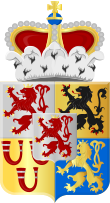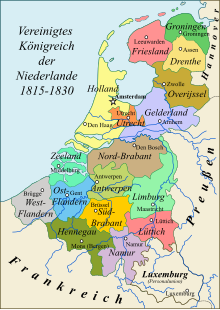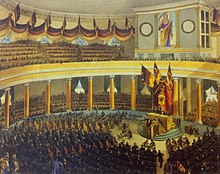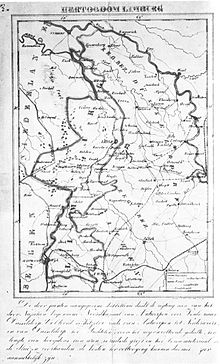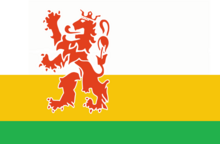Duchy of Limburg (1839–1866)
|
||||||||||||||||||||||||||||||||||||||
The Duchy of Limburg ( Dutch Hertogdom Limburg ) existed from 1839 to 1866. The area was identical to the Dutch province of Limburg . The Duchy of Limburg was established in 1839 as a member state of the German Confederation and existed until its dissolution in 1866 .
This 19th century duchy should not be confused with the old duchy of Limburg . It had existed from the early 11th century in the Holy Roman Empire until 1793. France annexed it in the Revolutionary Wars . That old duchy was south of the new duchy.
The Kingdom of the United Netherlands from 1815 initially comprised what is now the Netherlands and what is now Belgium . One of the provinces in the kingdom was called Limburg . In addition, the Grand Duchy of Luxembourg had the Dutch King as Grand Duke (1815-1890).
In 1830 an uprising broke out in the south of the previously unified Netherlands. This is how the new Belgian state came into being . Belgium captured the Catholic province of Limburg, and there was an uprising in Luxembourg too . After military conflicts, the following solution was found in 1839: Luxembourg permanently lost the French-speaking western part to Belgium, the remaining Grand Duchy was still a member state of the German Confederation. Limburg was divided into a province of Belgium and a province of the Netherlands at the London Conference (1838/39) .
The Dutch king, in his capacity as Grand Duke of Luxembourg, in the Bundestag of the German Confederation own Virilstimme . However, with the division of Luxembourg, fewer people lived in the rest of the Grand Duchy than before, so that one's own voice could no longer be justified. That is why the German Confederation accepted the Dutch province of Limburg as a further member state . This compensated for the population loss.
For this purpose, Dutch Limburg received the status of a duchy. It was not a province and did not elect members to the Dutch parliament, but was de facto under the Dutch administration. Because the German Confederation was only a confederation of states , this solution seemed tolerable from the German point of view. For the Dutch king it had the advantage that the military protection of the German Confederation now also extended to this area.
In the revolutionary time of 1848/1849, however, consideration was given to including Dutch Limburg in the German nation-state : if the area was not allowed to join liberal Belgium, the Limburg members of the Frankfurt National Assembly thought , then at least revolutionary Germany. After the Dutch king had improved the situation of the Limburgs, the pro-German direction lost approval.
With the dissolution of the German Confederation in 1866, Limburg became a Dutch province. The title of duke existed until 1906.
Netherlands, Luxembourg and Limburg during the restoration period
The Dutch King Wilhelm I had received a large, united kingdom through the Congress of Vienna in 1814/1815, but showed little inclination to meet the expectations associated with it. He treated Luxembourg , whose Grand Duke he became, almost like part of the Netherlands: he simply added the Luxembourg federal troops to his Dutch army, and Luxembourg also sent members of the Dutch parliament . Because of Luxembourg, he was allowed to send an envoy to the Frankfurt Bundestag . After all, he paid a few thousand guilders a year into the federal treasury to avoid being accused of an open breach of the covenant. Even more so, Wilhelm didn't think much of the idea of letting the entire Netherlands join the German Confederation.
Conversely, the German Confederation did not become very active when the Belgian Revolution broke out in 1830 and carried Luxembourg along with it. The federal government guaranteed its members the ownership and also decided on a federal execution (March 1831). However, he did not do this because a war with France was feared. The uprising could only be repulsed around the fortress of Luxembourg by the federal troops from Prussia stationed there.
In the semi-German Grand Duchy of Luxembourg, the uprising was mainly due to dissatisfaction with Dutch taxes. In the province of Limburg, sympathy for the liberal-Catholic Belgian revolution was more sustained. Only in the south of the (then undivided) province of Limburg, in the fortress city of Maastricht , could the king's troops hold out.
At that time there was fear of a Franco-German war on Belgian soil. So King Wilhelm thought that the whole of the United Kingdom of the Netherlands could still join the German Confederation. So the kingdom would have been protected from France. Should the king no longer be able to regain his power over Belgium, then, in his opinion, Belgium and Luxembourg should join the German Confederation, either with Wilhelm or with a Catholic German prince as monarch. Belgium would be saved from French annexation. In fact, joining would have been extremely unpopular with residents of both the northern and southern Netherlands.
At the London Conference in 1830/1831 the great powers discussed Belgium. Belgium itself saw Luxembourg as its own province, without prejudice to Luxembourg's federal membership. The Germans, however, did not want a Belgian province as a member of the German Confederation. France supported Belgium in this, after it had not been able to incorporate Luxembourg itself and therefore hoped to make Belgium its vassal state in the future.
Limburg in the German Confederation from 1839
In the years to come, King William tried to retake Belgium or at least improve his negotiating position. In 1839, however, both Wilhelm and the Belgians had to reluctantly agree to a compromise that had essentially been in place as early as 1831. Luxembourg was divided: the predominantly French-speaking western part went to Belgium, the German-speaking eastern part remained as Wilhelm's Grand Duchy including the federal fortress in the German Confederation.
For this purpose, the province of Limburg was divided between Belgium and the Netherlands. As the Duchy of Limburg, Dutch Limburg remained subject to Dutch succession, constitution and administration. However, it also became part of the German Confederation, with the exception of the fortresses Maastricht and Venlo with their immediate vicinity. The German Bundestag accepted the exchange on September 5, 1839; the German Confederation had lost around 150,000 inhabitants in Luxembourg and gained just as many in Dutch Limburg.
Wilhelm considered it an advantage that Limburg was now militarily under the protection of the German Confederation, while the German side finally saw the strategically favorable Maas line realized. That made a French attack less likely. The conservative great powers Austria , Prussia and Russia in particular were satisfied that revolutionary Belgium could not realize its maximum demands. Nevertheless, it contradicted the spirit and letter of the German Federal Constitution that an area represented both German federal territory and the province of a foreign power. If the Bundestag and the Dutch government had insisted on their respective rights, conflicts would have arisen immediately. Furthermore, in the event of war, the “German” Duchy of Limburg could have become the opponent of a power with which the Dutch province of Limburg had good relations.
A conflict broke out in 1846/1847. Austria in particular urged the German Confederation to introduce uniform press censorship . However, this would have violated the Dutch constitution in Limburg . In addition, censorship would hardly have been enforceable in the federal territory of Limburg alone; reading of newspapers from Maastricht, Venlo and the rest of the Netherlands would have had to be prevented. A corresponding federal resolution was then no longer passed.
Demands of the National Assembly in 1848
It is true that there had been individual German nationalists in the pre-March period who wanted to include the entire Netherlands in a new German empire . However, they initially held back in the National Assembly. This also applied to Rhenish trade circles, who had previously quarreled with the Netherlands about shipping on the Rhine and now hoped for close German-Dutch cooperation under the sign of liberalism . Two Limburgers had been elected to the National Assembly, one of whom wanted to see the Limburg issue dealt with immediately. Baron Jan Lodewijk van Scherpenzeel Heusch wrote to the National Assembly on May 24, 1848 that he could only take his seat when it had been decided that Limburg would no longer belong to the Netherlands. A corresponding motion from the legitimation committee was accepted.
Scherpenzeel wanted to take advantage of the special constitutional situation of the Duchy of Limburg to join the area, if not Belgium, then at least Germany. He expected that the Belgian model of the liberal-constitutional monarchy would also prevail in Germany. Economically, he also expected Limburg to be advantageous: it had little connections to the north, and the division of Limburg had cut it off from its former hinterland. In addition, there was bitterness that Limburg should pay the debts of the old Netherlands.
The Dutch government tried to undo the ties of 1839 for Limburg. She refused to pay the Limburg contribution to the imperial fleet or to send the Limburg military contingent to the Federal War against Denmark.
On July 19, 1848, there was a major debate in the National Assembly about the one motion that Limburg should be regarded as a German state, that Limburg could not be under Dutch administration as before, and that the German government with the Netherlands over the financial burden should speak. Some speakers, such as Ernst Moritz Arndt, said that the Germanic Netherlands had to be attached to the Reich for trade-policy reasons, but most only referred to the content of the proposal, which was accepted almost unanimously.
In Limburg the decision led to great jubilation in black, red and gold color decorations, the majority for Germany was not so great at any other phase. Pro-German and pro-Dutch petitions arrived in Frankfurt. When some Limburgers began to stop paying taxes, the Dutch government announced that the status of the duchy could only be changed in agreement with The Hague. She underscored her will with troop demonstrations after the Limburg governor had avoided confrontations without giving up positions. In the Dutch Second Chamber , the majority were against the separation of Limburg for reasons of national prestige. On the other hand, however, she was not prepared to bear the costs of mobilization, for example.
The German public welcomed the connection of Limburg, but did not consider the question to be very significant. The German government delayed implementation of the July 19 resolution; she knew that the Limburg status was linked to a complicated constellation on the border with the Netherlands and Belgium. Some of the statements made in the National Assembly were not designed to allay foreigners' fear of the power of a united Germany. The German side was at least credited with the fact that Limburg had already belonged to the German Confederation.
On September 1, 1848, there was a debate in the National Assembly on the implementation of the July 19 resolution; the associated motion, which amounted to a vote of no confidence, was rejected. In November the National Assembly reaffirmed its decision, but interest in Limburg had clearly subsided. The National Assembly concentrated on drafting the imperial constitution . In the meantime, the situation in the Netherlands had long since stabilized, with liberal constitutional changes and an improvement in the status of the Limburgers.
International reactions

Austria was more against a separation of Limburg from the Netherlands, because it saw in it a precedent for the separation of German-speaking areas from Austria in order to make them part of the German federal state. However, Austria was initially unable to provide effective support to The Hague due to its internal problems. Then later it would have welcomed a friendly settlement to improve the current situation, and the Dutch should have made concessions in the process.
The Netherlands liked to see the estrangement between Berlin and Frankfurt, but the Prussians wanted to make themselves the representative of the national cause. Prussia wanted Limburg to have closer ties to Germany for military reasons alone. On July 31, 1848, the Prussian government finally replied to the Netherlands that it considered a new regulation necessary.
It was not until July 23 that the Netherlands recognized the government of the French Republic . Two days later the Dutch envoy in Paris heard from the French foreign minister a very negative opinion about the Frankfurt National Assembly. In the future, Alsace would certainly also be challenged. The Dutchman's warning that the fortresses of Maastricht and Venlo should not fall into German hands also caught on. France was adopting a wait-and-see and cautious attitude at this point anyway. France did not have the means to go to war, militarily and financially, and was without allies; the government was not yet firmly in the saddle. France might have tried to prevent the fortresses on the Meuse from becoming German, but accepted it if, for example, part of West Limburg had been separated from the Netherlands.
In The Hague, it was expected that England would speak out against German claims on Limburg, just as in the Schleswig-Holstein case. After all, England has always acted as the protector of the small powers on the continent. But Foreign Secretary Palmerston ignored a corresponding Dutch letter in June because the matter did not appear to him to be very urgent or very important. In a speech before the House of Commons , the conservative opposition politician Disraeli then compared the Limburg question with Schleswig-Holstein. In his opinion, both cases testified to an aggressive-annexionist attitude in Germany. Palmerston held back in his answer: The government had to find out more and was waiting for explanations from the Dutch.
On August 16, the Netherlands received a very cold reaction from Palmerston. In The Hague one got the impression that England viewed the Limburg question only as a matter between the German Confederation and one of its members. Like other federal areas, Limburg also sent delegates to Frankfurt to reform the federal constitution . If the federal states the new constitution becomes too unitarian (unitary state), then it is up to them together to oppose it.
The reason for Palmerston's attitude was that in August the Italian affairs lay claim to him, that the Frankfurt resolution of July 19 had not yet been implemented, and that the Germans did not claim the two Meuse fortresses. Otherwise the British reaction would have been different. In addition, Palmerston did not want to endanger the expected German-Danish armistice by promoting a conflict with Berlin elsewhere.
Only Belgium and Russia had explicitly defended the Dutch claim to Limburg, but Belgium was neutral and Russia only supported the Netherlands morally. Because of the attitude of the great powers, The Hague would probably have backed down if Germany had pushed for swift negotiations after July 19. But rushing ahead would again have been strongly condemned by the great foreign powers. The result would have been a compromise, which in turn would have brought the German Reich government into conflict with the National Assembly.
Dissolution of the German Confederation in 1866
When the Prussian Prime Minister Otto von Bismarck presented a plan to reform the German Confederation on June 10, 1866 , he already planned for Limburg and Luxembourg to leave the Confederation. After the German War of July / August 1866, the German Confederation was dissolved. Limburg and Luxembourg did not want to belong to the future North German Confederation , and Bismarck did not make any serious effort to do so because a foreign sovereign would have posed a problem in a federal state.

The fate of Luxembourg, in which France had an interest but also had a Prussian garrison , remained controversial at first . It was no longer a federal fortress after the dissolution of the Confederation , but Prussia relied on Prussian-Dutch treaties and left the garrison there. In talks with France, Bismarck had promised to put pressure on the Netherlands, so that for tactical reasons he informed The Hague on August 23, 1866 that Limburg and Luxembourg should belong to the North German Confederation.
In the course of the Luxembourg crisis , it was confirmed at the London conference in May 1867 that the dissolution of the German Confederation had also meant the dissolution of Luxembourg and Limburg's ties to this confederation (Art. VI). The title of duchy lost its importance after leaving, since Limburg was only a province of the Netherlands, but it remained until 1906.
The Limburgers themselves remained reserved towards the Kingdom of the Netherlands for a long time. After all, before 1830 they had belonged to the southern Netherlands, with which they were culturally and economically connected through the Catholic religion. The Limburgers had only been assimilated since the First World War , when they were spared the fate of the Belgians in the neutral Netherlands.
Dukes
- 1839–1840 Wilhelm I
- 1840–1849 Wilhelm II
- 1849–1866 Wilhelm III
After 1866 the title Hertog van Limburg remained as a personal nobility title for Wilhelm III. consist. Due to the law on the nobility, titles of nobility could not pass to the female line of the descendants, so that Wilhelm III. the last bearer of the nobility title "Duke of Limburg" was.
In memory of the complicated circumstances and changing affiliations as a duchy and generational state , the Dutch queen's representative for Limburg was still unofficially referred to as an administrator (governor) among the population .
flag
There was no officially confirmed flag. However, from 1841 onwards, a red and white longitudinally striped flag was propagated (proportions and colors not binding). The colors were derived from the officially approved coat of arms.
Oddities
August Heinrich Hoffmann von Fallersleben composed the song of the Germans in 1841 . This poem became the German national anthem in 1922. The song line from the Maas to the Memel is explained by the Duchy of Limburg, through which the Maas river flows.
See also
Individual evidence
- ↑ Johan Christiaan Boogman: Nederland en de Duitse Bond 1815-1851 . Diss. Utrecht, JB Wolters, Groningen / Djakarta 1955, pp. 5-8.
- ↑ Johan Christiaan Boogman: Nederland en de Duitse Bond 1815-1851 . Diss. Utrecht, JB Wolters, Groningen / Djakarta 1955, pp. 14-15.
- ↑ Johan Christiaan Boogman: Nederland en de Duitse Bond 1815-1851 . Diss.Utrecht, JB Wolters, Groningen / Djakarta 1955, p. 16.
- ↑ Johan Christiaan Boogman: Nederland en de Duitse Bond 1815-1851 . Diss. Utrecht, JB Wolters, Groningen / Djakarta 1955, pp. 18/19.
- ↑ Johan Christiaan Boogman: Nederland en de Duitse Bond 1815-1851 . Diss. Utrecht, JB Wolters, Groningen / Djakarta 1955, pp. 20/21.
- ↑ Johan Christiaan Boogman: Nederland en de Duitse Bond 1815-1851 . Diss. Utrecht, JB Wolters, Groningen / Djakarta 1955, pp. 49–51.
- ↑ Johan Christiaan Boogman: Nederland en de Duitse Bond 1815-1851 . Diss. Utrecht, JB Wolters, Groningen / Djakarta 1955, pp. 52/53, 55.
- ↑ Johan Christiaan Boogman: Nederland en de Duitse Bond 1815-1851 . Diss. Utrecht, JB Wolters, Groningen / Djakarta 1955, pp. 183/184.
- ^ Günter Wollstein: The 'Greater Germany' of the Paulskirche. National goals in the bourgeois revolution of 1848/1849. Droste Verlag: Düsseldorf, 1977, pp. 245/247.
- ^ Günter Wollstein: The 'Greater Germany' of the Paulskirche. National goals in the bourgeois revolution of 1848/1849. Droste Verlag: Düsseldorf, 1977, p. 246.
- ^ Ernst Rudolf Huber: German constitutional history since 1789. Volume II: The struggle for unity and freedom 1830 to 1850 . 3rd edition, Verlag W. Kohlhammer, Stuttgart [ua] 1988, p. 646.
- ^ Günter Wollstein: The 'Greater Germany' of the Paulskirche. National goals in the bourgeois revolution of 1848/1849. Droste Verlag: Düsseldorf, 1977, pp. 247-249.
- ^ Günter Wollstein: The 'Greater Germany' of the Paulskirche. National goals in the bourgeois revolution of 1848/1849. Droste Verlag: Düsseldorf, 1977, pp. 250/251.
- ↑ Johan Christiaan Boogman: Nederland en de Duitse Bond 1815-1851 . Diss. Utrecht, JB Wolters, Groningen / Djakarta 1955, p. 603.
- ^ Günter Wollstein: The 'Greater Germany' of the Paulskirche. National goals in the bourgeois revolution of 1848/1849. Droste Verlag: Düsseldorf, 1977, p. 251.
- ^ Günter Wollstein: The 'Greater Germany' of the Paulskirche. National goals in the bourgeois revolution of 1848/1849. Droste Verlag: Düsseldorf, 1977, pp. 253/254.
- ↑ Johan Christiaan Boogman: Nederland en de Duitse Bond 1815-1851 . Diss. Utrecht, JB Wolters, Groningen / Djakarta 1955, pp. 559/560, 562/563.
- ↑ Johan Christiaan Boogman: Nederland en de Duitse Bond 1815-1851 . Diss. Utrecht, JB Wolters, Groningen / Djakarta 1955, pp. 563-565.
- ↑ Johan Christiaan Boogman: Nederland en de Duitse Bond 1815-1851 . Diss. Utrecht, JB Wolters, Groningen / Djakarta 1955, pp. 569-571, pp. 572/573.
- ↑ Johan Christiaan Boogman: Nederland en de Duitse Bond 1815-1851 . Diss. Utrecht, JB Wolters, Groningen / Djakarta 1955, p. 576/577, p. 581.
- ↑ Johan Christiaan Boogman: Nederland en de Duitse Bond 1815-1851 . Diss. Utrecht, JB Wolters, Groningen / Djakarta 1955, pp. 583/584.
- ↑ Johan Christiaan Boogman: Nederland en de Duitse Bond 1815-1851 . Diss. Utrecht, JB Wolters, Groningen / Djakarta 1955, p. 587.
- ↑ Johan Christiaan Boogman: Nederland en de Duitse Bond 1815 to 1851 . Diss. Utrecht, JB Wolters, Groningen / Djakarta 1955, p. 594.
- ^ Ernst Rudolf Huber: German constitutional history since 1789. Volume III: Bismarck and the realm . 3rd edition, W. Kohlhammer, Stuttgart a. a. 1988, p. 694.
- ^ Ernst Rudolf Huber: German constitutional history since 1789. Volume III: Bismarck and the realm . 3rd edition, W. Kohlhammer, Stuttgart a. a. 1988, p. 695.
- ↑ Johan Christiaan Boogman: Nederland en de Duitse Bond 1815-1851 . Diss. Utrecht, JB Wolters, Groningen / Djakarta 1955, 199-201.
- ↑ Jos Poels, Guus Urlings: Hoog in top. 60 jaar Limburgse vlag 1953-2013 , Mooi Limburgs Boekenfonds, Provincie Limburg 2013, ISBN 978-90-8596-092-8 , p. 18 ff.
